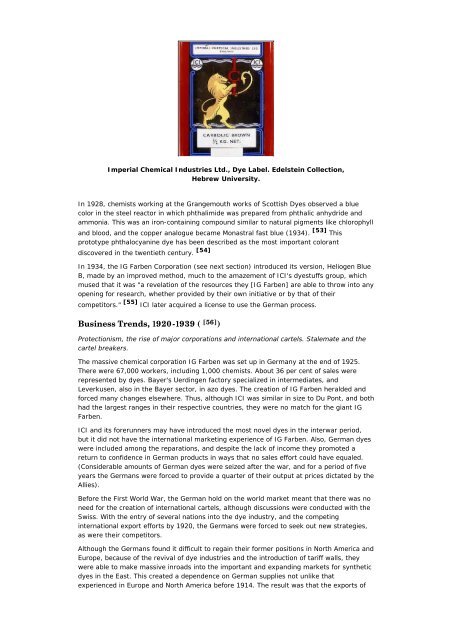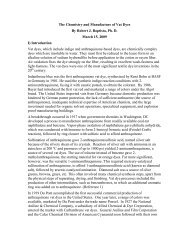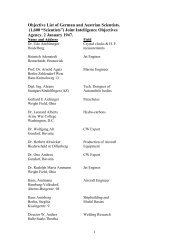International Dyestuff Industry - ColorantsHistory.Org
International Dyestuff Industry - ColorantsHistory.Org
International Dyestuff Industry - ColorantsHistory.Org
Create successful ePaper yourself
Turn your PDF publications into a flip-book with our unique Google optimized e-Paper software.
Imperial Chemical Industries Ltd., Dye Label. Edelstein Collection,<br />
Hebrew University.<br />
In 1928, chemists working at the Grangemouth works of Scottish Dyes observed a blue<br />
color in the steel reactor in which phthalimide was prepared from phthalic anhydride and<br />
ammonia. This was an iron-containing compound similar to natural pigments like chlorophyll<br />
and blood, and the copper analogue became Monastral fast blue (1934). [53] This<br />
prototype phthalocyanine dye has been described as the most important colorant<br />
discovered in the twentieth century. [54]<br />
In 1934, the IG Farben Corporation (see next section) introduced its version, Heliogen Blue<br />
B, made by an improved method, much to the amazement of ICI's dyestuffs group, which<br />
mused that it was "a revelation of the resources they [IG Farben] are able to throw into any<br />
opening for research, whether provided by their own initiative or by that of their<br />
competitors." [55] ICI later acquired a license to use the German process.<br />
Business Trends, 1920-1939 ( [56] )<br />
Protectionism, the rise of major corporations and international cartels. Stalemate and the<br />
cartel breakers.<br />
The massive chemical corporation IG Farben was set up in Germany at the end of 1925.<br />
There were 67,000 workers, including 1,000 chemists. About 36 per cent of sales were<br />
represented by dyes. Bayer's Uerdingen factory specialized in intermediates, and<br />
Leverkusen, also in the Bayer sector, in azo dyes. The creation of IG Farben heralded and<br />
forced many changes elsewhere. Thus, although ICI was similar in size to Du Pont, and both<br />
had the largest ranges in their respective countries, they were no match for the giant IG<br />
Farben.<br />
ICI and its forerunners may have introduced the most novel dyes in the interwar period,<br />
but it did not have the international marketing experience of IG Farben. Also, German dyes<br />
were included among the reparations, and despite the lack of income they promoted a<br />
return to confidence in German products in ways that no sales effort could have equaled.<br />
(Considerable amounts of German dyes were seized after the war, and for a period of five<br />
years the Germans were forced to provide a quarter of their output at prices dictated by the<br />
Allies).<br />
Before the First World War, the German hold on the world market meant that there was no<br />
need for the creation of international cartels, although discussions were conducted with the<br />
Swiss. With the entry of several nations into the dye industry, and the competing<br />
international export efforts by 1920, the Germans were forced to seek out new strategies,<br />
as were their competitors.<br />
Although the Germans found it difficult to regain their former positions in North America and<br />
Europe, because of the revival of dye industries and the introduction of tariff walls, they<br />
were able to make massive inroads into the important and expanding markets for synthetic<br />
dyes in the East. This created a dependence on German supplies not unlike that<br />
experienced in Europe and North America before 1914. The result was that the exports of





